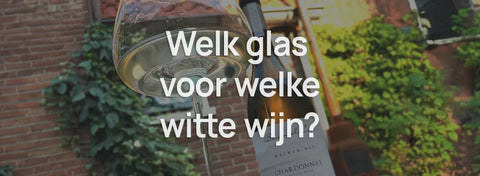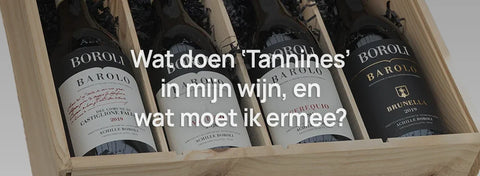Why does the glass for your white wine make all the difference?
I'll explain that to you. Incidentally, this applies equally to red wine and sparkling wine, but let's focus on white wine here. I'll come back to red wine another time, and I'll explain sparkling wine here as well.
Anyway. Imagine you just spent €30 on a beautiful Chardonnay. You pour it into that lovely tall glass you got for your birthday, take a sip... and wonder where the complexity the winemaker promised has gone? And that creaminess you expected?
The problem?
You're using the wrong glass.
*I'm hypothetically assuming here that you're serving the wine at the right temperature, not too old, not too young, and you're not eating lemon bars with it.
A bit of an inconvenient truth: even the best white wine in the world tastes mediocre in the wrong white wine glass . And conversely, even that cheap bottle will perform better than expected in the right glass.
As a wine lover, you invest in good bottles. But often you drink them from glasses whose design wastes your money. We can do something about that.
Why you get specific glasses per wine in some restaurants
Restaurants that are serious about wine have different glasses for a reason. Not for show, not to impress, but because it elevates the wine experience. It also helps them pair relatively inexpensive wines with your menu, but that's beside the point.
A good sommelier knows that a Riesling has different requirements than a Chardonnay. That a temperature within two degrees makes the difference between elegant and flat. That the shape of the glass can make or break a wine.
At home, we reach for the biggest glass in the cupboard. "Bigger is better, right?" But that's not always true. The rule that white wine looks better in smaller glasses is also wrong. You really want to consider the grape variety you're drinking, and your own preferred style.
Maxi Riedel and I

Time for an anecdote: many years ago, I went to ProWein for the first time. It's a very large wine fair where you can taste wines from all over the world, but sometimes also experience other things.
We happened to pass by the Riedel stand, where this wine hero was working: Maxi Riedel . You might know him from Insta with his famous color checks and Sunday Wine Fundays . If you're not following us there yet, check him out: @Perfectewijn.nl. Anyway, back to the story. Maxi Riedel is now the head of Riedel.

©Riedel.com
His family has been making wine glasses for generations, and they know what they're doing. He let us taste the same wine, but from three different glasses.
A Riesling, from three different glasses:
- Chardonnay glass
- Riesling glass
- Sauvignon glass
And they look like this:

The science behind that perfect wine glass

So why these differences in glasses? The shape of your glass determines three crucial things:
- How aromas reach your nose;
- How temperature is maintained;
- And which parts of your tongue come into contact with the wine first.
White wines thrive on their aromas. Even more so than red wines. Those delicate scents of citrus blossom, minerals from the soil, subtle herbs—that's where the magic lies. The wrong glasses let those aromas escape before they can enrich your experience.
A narrow white wine glass concentrates aromas like a funnel concentrates water. Instead of letting scents escape into a wide opening, the tulip shape directs everything to a single point: your nose.
This isn't marketing talk. It's pure physics. Aroma compounds are volatile; they want to escape. A wide opening gives them plenty of room. A narrow opening forces them together, creates concentration, and suddenly reveals subtle nuances.
A wide glass is certainly not a bad thing, sometimes you need it to release the aromas, to prevent the alcohol from lingering in your glass, and for some of the acidity to dissipate.
In a wine glass, uh, nutshell:
If your wine needs acidity, freshness, and isn't too full-bodied, like Sauvignon Blanc, Gewürztraminer, or Riesling, use a narrow glass . If your wine needs creaminess, butteriness, or licorice notes, like Chardonnay or Chenin Blanc, use a wide glass.
Of course, the style of the wine and the house still makes a difference, but that's a step further.
The next step is to determine what you often drink, and therefore what you think is worth buying glasses for.
Personal advice: glasses for Pinot Noir/Nebbiolo, Cabernet Sauvignon and Chardonnay, that will get you a long way.
And what about those bubbles?
Yes, I'd like to come back to that. Typically, you drink bubbles in a flute, or perhaps a coupe. The problem with the former is that there's almost no oxygen in it.
A flute is very narrow, and carbon dioxide pushes air out through that narrow tube, so the taste and experience are hard to come by.
For the coupe, it's the exact opposite: it flies away, but the carbon dioxide also flies away. A waste of the idea of bubbles... unless you're a very quick drinker.
What then?
Pour those bubbles into a larger white wine glass, and you'll sooner realize that sparkling wine is really wine.
Frequently Asked Questions
-
So large wine glasses are not necessary?
I'm not saying that. A large wine glass often gives you more space to release aromas. With some wines, you don't want that, but in many cases, you do. However, the shape is often more important.
-
Are expensive glasses better?
No. Unfortunately, "no" alone doesn't cover it all. Glasses specifically for a particular type of wine are often more expensive because they're not made by everyone. They also often come in crystal or are hand-blown. All factors that drive up the price.
-
How much does a small wine glass cost?
That makes quite a difference. First, determine which glasses you really have room for, both in terms of cupboard space and budget. What wine you drink often, and then start browsing.
-
Is there a universal glass?
Yes, definitely, universal glasses are used for wine courses. This allows for testing standards and a level playing field. However, it's about recognizing wine, grapes, how it's made, and quality, not about enjoying it. And of course, you'd prefer to do that at home.


Comments (0)
There are no comments for this article. Be the first one to leave a message!